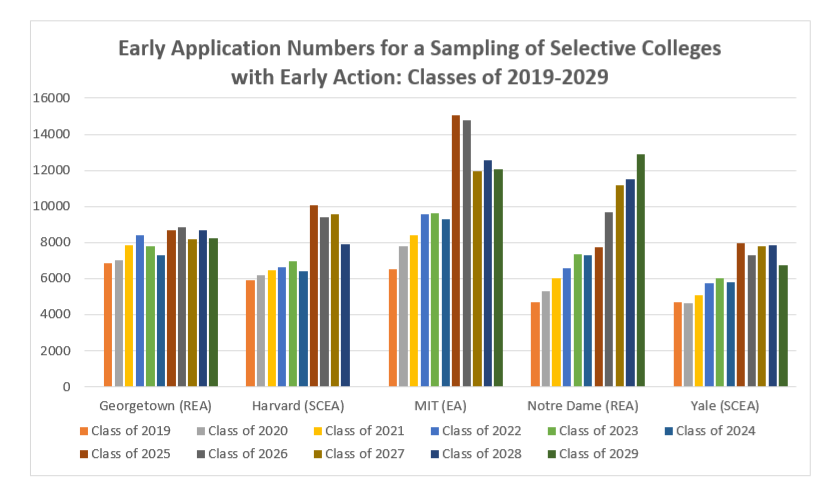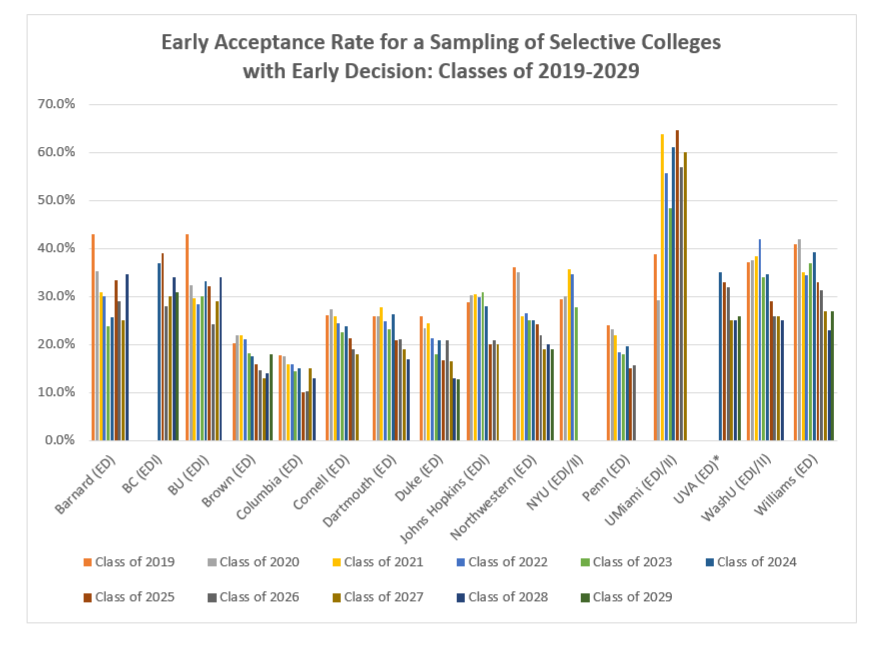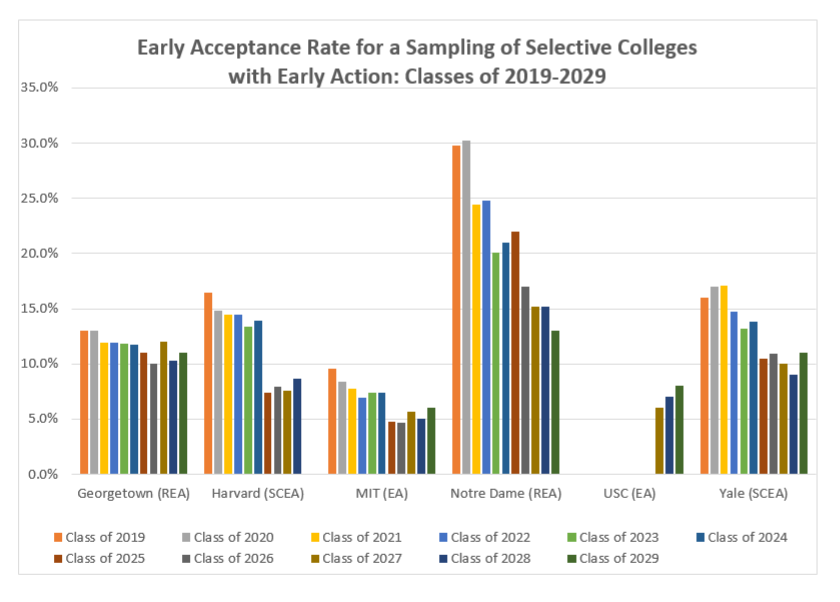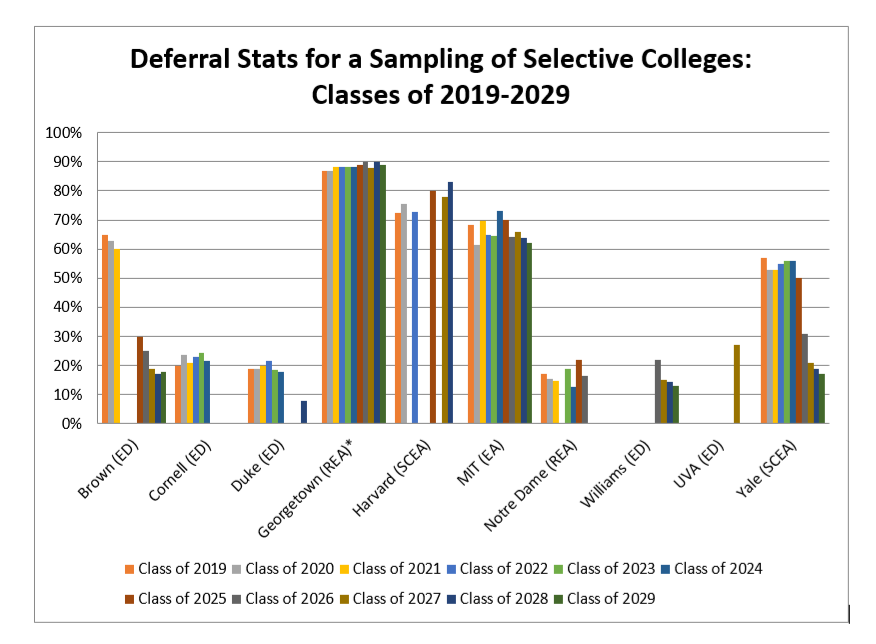 For the Class of 2029, early applications continued to remain high at many selective schools, and as a result, early acceptance rates remained low. Some schools reinstated test requirements this year, and more and more schools are not releasing early admissions statistics. In this blog post, we will analyze the information that was released, look for overall trends in early admissions, and offer tips for future applicants. Congratulations to all students who submitted early applications—your diligence will benefit you in the admissions process!
For the Class of 2029, early applications continued to remain high at many selective schools, and as a result, early acceptance rates remained low. Some schools reinstated test requirements this year, and more and more schools are not releasing early admissions statistics. In this blog post, we will analyze the information that was released, look for overall trends in early admissions, and offer tips for future applicants. Congratulations to all students who submitted early applications—your diligence will benefit you in the admissions process!
Overall Early Application Trends
Early applications remain high, as many students apply early decision and early action to demonstrate interest, increase their chances, qualify for merit scholarship consideration, and gain some certainty earlier in the college admissions process.
Many selective schools experienced a rise in early application numbers. Colleges that saw an increase in applications this year compared to last year include Boston College (up 15%) Duke (up 8%), Emory (up 21%), Northwestern (up 15%), Notre Dame (up 16%), NYU (up 10%), Penn (up 12%), and UVA (up 11%).
Some schools that reinstated test score requirements for the first time since Covid saw a drop in early applications this year compared to last year. Brown had a 19% drop in ED apps this year and Yale EA apps were down 14% compared to last year. Both schools reinstated a test score requirement for this cycle. Dartmouth also reinstated a test score requirement this year and their early apps remained flat compared to last year. Georgetown (down 5%) and MIT (down 4%) have required test scores for several cycles, but also saw a drop in early applications from last year. Harvard also reinstated a test score requirement this year and did not release any early admissions data. Other highly selective schools that still offer test-optional admissions but also saw a slight drop in early applications compared to last year include Columbia (down 2%) and Williams (down 10%).
Trends in Standardized Testing Admissions Policies
Keep in mind that Georgetown, MIT, University of Florida, and University of Georgia began requiring test scores early on after Covid. Purdue has had a “test expected” policy since the 2023-2024 admission cycle. Many more highly selective schools reinstated a test requirement this year for the 2024-25 application cycle, including Brown, CalTech, Dartmouth, Harvard, and Yale (test-flexible).
Several highly selective schools reinstated a test requirement for the Class of 2029. These schools pointed to the important information that testing provides about a prospective student’s ability to succeed in college as part of a holistic application review.
Beginning in the 2025-26 admission cycle, UT-Austin will reinstate a test score requirement, as will Cornell and Stanford. For the 2026-27 admission cycle, the University of Miami announced that test scores will be required, and Carnegie Mellon is planning for a test-flexible policy. Johns Hopkins is encouraging the submission of test scores for the 2025-26 application cycle and requiring the SAT or ACT for the 2026-27 cycle.
We continue to recommend that students take standardized tests as part of the application process and submit scores if they are competitive. Keep in mind that test-optional is not the same as test-blind! Strong scores will still provide a competitive advantage in the admissions process.
Steady Early Acceptance Rates
Overall, for schools that reported information, the acceptance rates remained fairly steady from this year to last year. But early acceptance rates ticked up slightly for some highly selective schools. Brown accepted 18% of its ED applicants this year, compared to 14% last year, and Williams accepted 27% of ED applicants compared to 23% last year.
Georgetown increased from a 10% early action acceptance rate last year to 11% this year, and Yale’s early acceptance rate rose from 9% last year to 11% this year. These are still crushingly low numbers!
Schools Release Less Information
It is important to stress the trend of schools releasing less and less information. Stanford was one of the first highly selective schools to stop releasing acceptance rates as students were admitted, which it began abstaining from in the 2018-2019 application cycle. In December 2021, Princeton announced that it would no longer release admissions statistics until the close of the year’s admissions cycle. For a few years, Columbia, Cornell, and Penn have also delayed the release of acceptance rates, and now Harvard and Johns Hopkins are also following suit. Statistics are not released until Class Profiles for incoming first year students are published in the fall or when the Common Data Set is published.
Trends in Early Application Numbers
The following graph compares early admissions application numbers and acceptance rates for the Class of 2019 through 2029. As a refresher, Early Decision (ED) is binding and mandates enrollment; Single Choice Early Action (SCEA) and Restrictive Early Action (REA) are restrictive but allow the student to wait until May 1st to decide; and Early Action (EA) is unrestrictive and non-binding. Early Decision is typically associated with higher acceptance rates because the school is guaranteed the student’s enrollment, which increases the yield factor, and results in a class comprised of students who have demonstrated a high degree of interest.
Early Admissions Statistics for a Sampling of Selective Colleges
*BC and UVA began ED programs in 2019
*Notre Dame changed its early admissions program from EA to REA in 2015.
*USC began its EA program in 2022.
Deferral Stats
The deferral policy of colleges varies widely. Available information shows that many schools defer more than half of their early applicant pool to the regular admissions round.
But notable exceptions include Duke, Middlebury, Northwestern, Notre Dame, and Stanford, who deny most applicants who are not accepted in the early round. For these schools, deferral is used to indicate that your application is very competitive because if you are not in line with the school’s admissions standards you would be denied; therefore you will be given serious consideration in the regular admissions process.
Yale has lowered its rate of deferral over the past several years. For the Class of 2025 and classes prior, close to 50% of early applicants were deferred. In contrast, for the Class of 2026, 31% were deferred and this year, only 17% were deferred and 71% were denied. Brown has also decreased its deferral rate. For the Class of 2021, 60% of ED applicants were deferred; this year only 18% received deferral and 62% were denied.
Some schools, like the University of Michigan, use large numbers of deferrals to control class size as they have continued to receive increasingly large early applicant pools. Some colleges defer especially strong candidates who may view the college as a “safe” school, wait to see if the student withdraws the application based on early acceptance by more selective colleges, and then may accept the student late-January through March.
Note that deferral rates are not as widely published as acceptance rates.
For deferred students, there are several steps you can take to increase your chances of admission in Regular Decision, including re-visiting, arranging for an additional letter of recommendation from a 12th grade teacher, and sending a follow-up letter with updates. Above all, stay positive, and continue to do your best academically.
Percent of Early Apps Deferred for Recent Classes
*Georgetown and USC defer all students who are not accepted EA. Georgetown says typically 15% of deferred applicants are admitted in the regular round.
Larger Percentages of Freshman Classes Filled with Early Applicants
Some schools continue to admit large portions of the freshman class through Early Decision, making the regular admissions cycle even more competitive. More students tend to apply through Regular Decision, so they are competing for fewer remaining positions in the class.
Barnard, Boston College, Boston University, Columbia, Cornell, Dartmouth, Duke, Northwestern, Rice, Skidmore, Tulane, Penn, WashU, and Williams admit 50% or more of their incoming class through their Early Decision program. The chart below shows the percentage of recent classes filled with ED admits.
Increased Diversity Continues to be a Priority – and a Challenge
Many of the most selective colleges have used early admissions in prior years to admit the big “hooks”: underrepresented minorities, lower socioeconomic, first-generation, and international students, as well as recruited athletes, and legacies. Following the Supreme Court ruling in 2023, colleges are prohibited from considering race in their admissions policies (but may consider the impact of “lived experience.”) The Class of 2028 underwent the first admissions cycle after this ruling.
Last year, after the 2023 Supreme court ban on affirmative action, many top universities reported a drop in first year enrollment for Black, Latino, and Indigenous students, including Brown, Harvard, Johns Hopkins, MIT, NYU, Penn, and Tufts. Yale and Dartmouth sustained stable numbers in their Class of 2028 first year enrollment for historically underrepresented groups compared to the Class of 2027.
For the Class of 2028, Grant Gosselin, Boston College’s Dean of Undergraduate Admission and Financial Aid, said “In response to the 2023 Students for Fair Admissions ruling, our office reviewed applications and made decisions in a race-blind environment while enhancing our focus on race-neutral factors that align with Boston College’s mission. Expanding our commitment to ensuring a wider range of socioeconomic representation among our student body was critical to our work.”
Demographics for the Class of 2029 will not be available until after May when students have accepted their regular decision offers.
Many colleges are using a variety of programs to attract top-quality students from diverse backgrounds, including American Talent Initiative, QuestBridge, the KIPP Foundation, and A Better Chance. Last year, UVA partnered with the Virginia College Advising Corps to create relationships with 62 Virginia high schools in an effort to increase the number of underrepresented students applying early.
QuestBridge College Match Program has matched students with many top universities, as its goal is to “connect the nation’s most exceptional, low-income youth with leading colleges and opportunities.” For the Class of 2029, many schools increased the number of students admitted through the QuestBridge Program. Brown admitted 90 students through QuestBridge (up from 64 last year) and this makes up 10% of their early admits. Duke admitted 113 QuestBridge students to the Class of 2029 (up from 97 last year), and MIT matched 100 QuestBridge students, which is almost double the number from last year!
Many schools are also looking for an increase in first-generation students. Columbia, Harvard, Yale and many other selective schools have joined the Small Town and Rural Students (STARS) College Network to enhance access and awareness to students living in places where attending college is not usually considered an option. Dartmouth joined STARS and now 15% of their ED admits to the Class of 2029 have a rural background.
Dartmouth is also one of the few selective schools that reports legacy admissions. 11% of Dartmouth ED admits are legacy and 25% of those students have two Dartmouth parents. More than half of the colleges that once considered legacy in their admissions process no longer do so. Last year, the states of California, Illinois, Maryland and Virginia joined Colorado in enacting restrictions on the use of legacy in admissions at universities within their state. Legacy admissions tend to benefit wealthy, white students, and this has become a new focus in terms of equity after the 2023 Supreme Court ruling on affirmation action.
Yale and other highly selective schools are using databases such as Opportunity Atlas and the College Board’s Landscape to determine the “economic mobility” of applicants, based on schools and neighborhoods.
It remains to be seen how successful colleges are this year in pursuing their institutional priorities for the Class of 2029.
Our Tips
We recognize how challenging it is to wait for your admissions results! Here are our tips to seniors for maximizing your chances:
- If you have a top choice college, send a Letter of Intent saying that you would attend if accepted (if you applied Early Action or Regular Decision)
- Send your other early admission colleges Letters of Continued Interest with updates about academics and activities
- Continue to engage in your academics; colleges want to see your midyear report and final report card
- Visit (or revisit) colleges in which you are most interested
- Keep a positive outlook and have faith in the process!
Deciding whether and where to apply early can be daunting, especially now. But whatever your question, Collegiate Gateway is happy to help you decipher your options and understand the changing landscape of early admissions.
We invite you to register for our upcoming presentation, Gateway to Success: Early Admissions Trends for the Class of 2029 on Wednesday, 2/26, at 8pm EST – 9pm EST.






